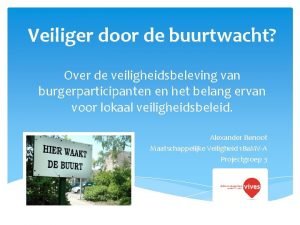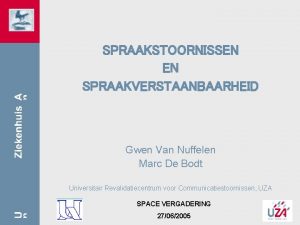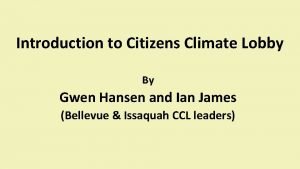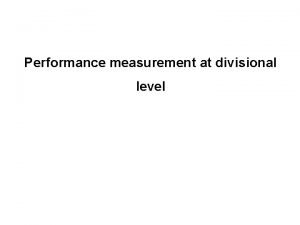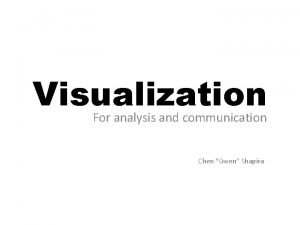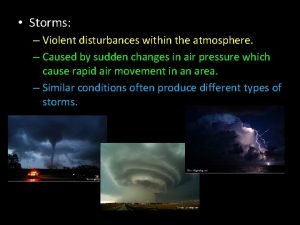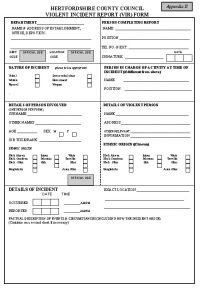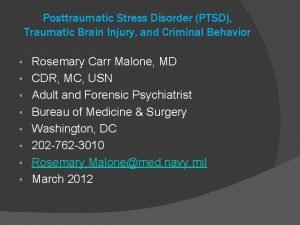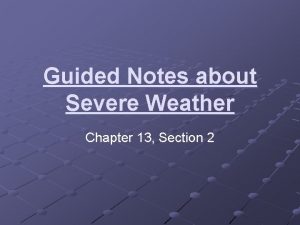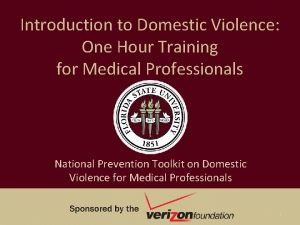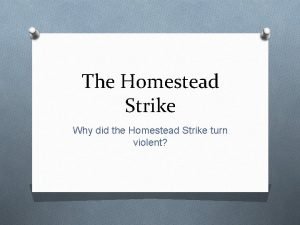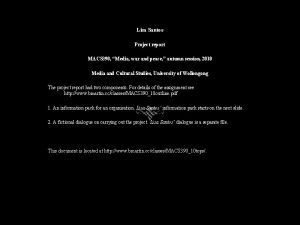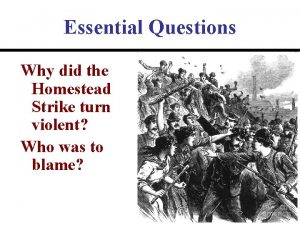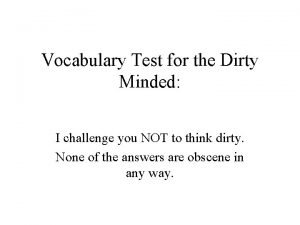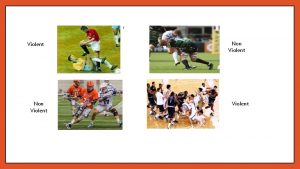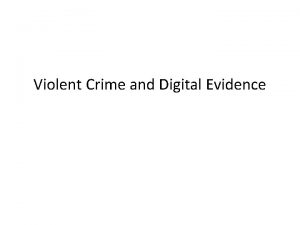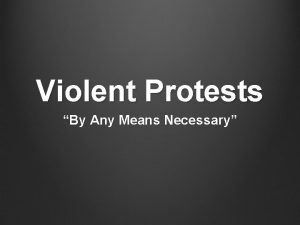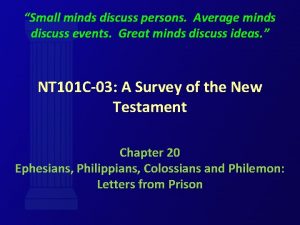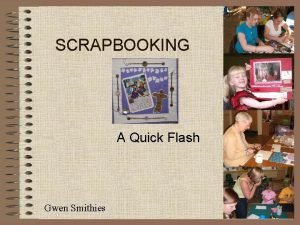Changing Minds 3 changing violent minds Professor Gwen





































![Narrative incoherence [The interviewer is asking about childhood disruptions: in this case parental divorce] Narrative incoherence [The interviewer is asking about childhood disruptions: in this case parental divorce]](https://slidetodoc.com/presentation_image_h2/536e9f9a78c59e89f59a30a6a073f12c/image-38.jpg)





- Slides: 43

Changing Minds 3: changing violent minds Professor Gwen Adshead June 2016

Supreme Court Jan 2011 Violence is not a term of Art. It is capable of bearing many meanings and applying to many different types of behaviour 2

Interpersonal violence: 20% of recorded crime Reducing over last 30 years But ? Unreported and unrecorded Types of violence: stabbing/assaults homicide sexual violence assaults on children 3

Commonest violence: assaults by young men on other men assaults by men on partners physical abuse of children Interpersonal Most violence takes place in context of relationships 4

Risk factors for violence Known risk factors: being young, male, socially isolated Paranoid mental states Substance misuse Poor reality testing Hyper-vigilance Insecure attachment Antisocial states of mind 5

Cultural risk factors - stereotypes about “acceptable” victims - denigration of weakness (e. g. as part of male gender role) - tolerance of substance misuse - tolerance of violence - access to weapons - violence by the state: income inequality 6

Ecological models of violence The culture, policies and laws The community The family The person G x Att 7

Mental states that increase risk of to violence • Different types of violence • Relational vs non-relational • Different states of mind – Affectful or affectless – Impulsive or controlled – Clear or confused – Excited or detached – Proactive or reactive

Do they have anything in common? • Disturbance of reality: personal, social • Threat perception problems • Disturbance of connection to others: others do not seem real or human • Absence of consequential reasoning: nothing will matter later because this isn’t real • The wish to hurt and denigration of vulnerability

Marilynne Robinson You live with your own mind all the time so you ought to be comfortable there 10

11

The violent state of mind • Those who are violent typically see others as threat or prey • They have little sense of agency: they see themselves as being acted on by others • They therefore feel justified in what they do: no anxiety • They overcome inhibitions to violence (VIM)

13

Seeing others as threat • Failure to mentalise negative affects of rage, hatred, fear • Projection of these feelings onto others • Panic, attack and contempt in response to conscious anxiety and perceived vulnerability • Unconscious identification with the aggressor

Seeing others as prey • Failure to mentalise feelings of neediness and vulnerability when these are stimulated • Projection of vulnerability onto others • Denigration and derogation of weakness and need in others • Identification with the aggressor

Self-justification: it feels right • Rigidity in moral reasoning: all or nothing thinking • Absence of forgiveness • Lack of empathy reduces anxiety • Strict dominance hierarchies: might is right • Reduction of shame and promotion of selfesteem

17

After the attack • Peace, relief, shame: like an addict • Amnesia and dissociation • Denial and minimisation • Despair: sets up the stimulus for the next attack “ I am afraid to think what I have done. . To look on it again, I dare not” 18

Post-traumatic phenomena in violence perpetrators • The self as victim or prey: passivity and helplessness • Hyper arousal and hyper vigilance to external threat • Lowered threshold for threat perception (paranoia) and poor distance regulation • Poor reality testing and discernment • Flashbacks and intrusion phenomena

20

The development of the antisocial mind • An antisocial mind sees others as threat or prey or both • No sense of connection with others: the absence of epistemic trust • Poor affect regulation: feeling and acting without thinking when feeling vulnerable • Or thinking with no feeling: absence of empathy • A fragmented and unstable sense of self 21

How do we develop a secure sense of self? • We ‘grow’ a self out of our growing social brain in the first 1000 days • Key variables: - genetic resilience and vulnerability - Interaction with carers: the attachment system - The carer’s mind is a major environmental input - Communication: physical and verbal 22

Mentalising: a process of interpersonal experience Mentalising: keeping mind in mind The psychological aspect of the social brain Self-reflective function: self/other Thinking about feeling and feeling about thinking • Capacity to mentalise associated with security of attachment relationship in mind • Self narrative • •

Mentalising in practice I feel I’m stuck in my previous age… the age I was when I did my offence. . Time’s passing here and there are things I’m not doing. . I want to capture time with magazines and pictures to know what I was doing when I was here… What will it be like in 10 years time? Where will we be? What will I think on my deathbed about this time? ’ 24

Proliferation of synapses

Failure to develop or maintain secure sense of self • Disorganised attachment – Enmeshed plus dismissing • Dismissing attachment: derogation of need in self and others • Somatisation as default • Poor sense of self boundary • Deficits in the psychic ‘skin’ ( Bick) • Failure of the mirror test (Cicchetti/Bateman)

Failure to develop a sense of emotional agency • Lack of emotional lexicon: especially for negative affects • Lack of symbolic function • Sparse and derogatory narratives • Derogation of attachment to self/groups • Lack of autobiographical competence “I can’t think”

Violence more likely when mentalising fails • For people with insecure attachment systems • Stimulation of attachment system (need or vulnerability) stimulates intolerable anxiety and increasing arousal • Low reflective function means anxiety and arousal soars • Physical discomfort makes physical action more likely • Poor reality testing and substance misuse are risky 28

Studies of attachment in perpetrators of violence • Insecure attachment is higher compared with general population • Dismissing attachment is over-represented in those who hurt others • Enmeshed attachment may be relevant to some types of relational violence • Likely to be one risk factor that mediates others e. g. substance misuse, social isolation 29

This thing of darkness I acknowledge mine……. 30

Treatment issues Does it make sense to ‘treat’ a crime? - Rather: we treat underlying antisocial mental states and attitudes -Risk as continuum not state - Therapy can consider the interpersonal context of risk: how do relationships increase risk for this person -the importance of groups as antidote to the antisocial 31

Therapies for violence Need good formulation of violence - an articulation of the part of the person’s mind that wishes to hurt and intimidate - how others come to be seen ‘merely as a means’ - the (brief) satisfaction in inflicting fear - Trust and security without excuse and forgiveness 32

Ownership and agency • There is a self or mentaliser who owns actions: who is the agent • The ‘real’ me, who is demonstrated by my actions and decisions • The ‘authentic’ self (Baldock, 2009) • High cost decisions need ‘truer’ authenticity • The idea of a self that can change: the exercise of choice and identity ( Maruna 2001)

Agency and responsibility • The language of offending • Research shows importance of reworking narratives of passivity into narratives of agency • Acceptance of the offender identity allows for change • E. g. It wasn’t me • It wasn’t me, it was my illness • I was ill when I did it • I killed her

So therapy for offenders… • Needs to take place in secure context: the secure base • Safe enough to speak the unspeakable; and acknowledge the tragedy of harm done • Acceptance of the offender self without redemption by therapist • Beware re-enactment of toxic attachments • A variety of media/techniques can be used 35

Group therapies • Utilise the pro-social to effect change • Attachment to the group itself is therapeutic • May reduce anxiety in the very insecure and paranoid • Good for working with shame “ I imagine this group will go on for ever. . Maybe in 200 years, it will still be going” 36

Quotes from the group • Not having a structured day is a killer • I’m worried about this form I have to get… it’s my P 45, or something like that’ • I’m fed up with myself. . . I don’t want to be me • I want to leave that part of me behind • I’m living in hope of freedom from my mind. 37
![Narrative incoherence The interviewer is asking about childhood disruptions in this case parental divorce Narrative incoherence [The interviewer is asking about childhood disruptions: in this case parental divorce]](https://slidetodoc.com/presentation_image_h2/536e9f9a78c59e89f59a30a6a073f12c/image-38.jpg)
Narrative incoherence [The interviewer is asking about childhood disruptions: in this case parental divorce] (Did they divorce? ) • Well I don’t know if he divorced [her] or not but all I know is that he left her in a sense that he told her about his companion as he called her and erm to cut a long story short I blamed him for her demise because the last flicker of flame in her belly had been extinguished.

What did she do when she heard? Of course, yeah, after being married to [him] since childhood days, see aunts and all the rest of it, you know from back in the army days and all the rest of it, and I thought well, he’s responsible for her demise, I was just grieving so much I didn’t know what to do so I thought I would kill him, erm probably glad that he wasn’t in really, he wasn’t in so I got in through the back door at the side of the house and went to go and hang myself in a tree but that didn’t work so I left

The same speaker T + 18 months • Ok how did you cope with [her death]? • Well I almost had a breakdown. . well it is a breakdown if you call it breakdown, first of all I went to harm my granddad because he’d taken on a companion and I’d found out before this, he told my grandmother while she was in hospital that he couldn’t enjoy his retirement, my mother knew this I said to her why has he done this and she said I don’t know …erm my grandmother died, I went to confront my grandfather with the intention of harming him, probably killing him actually at that time and it wasn’t him, luckily for me and for him, I don’t know what I would have done if I had got there if I had actually carried it out obviously I was very upset I was really grief stricken and I tried to hang myself in the garden, I broke into the garage and got some rope and tried to hang myself, erm and that is what happened when someone dies, I am not talking about my index offence, I am talking about as a child

Can they refuse to have therapy? • Can we force someone to become more prosocial? • Does the state have the right to insist that you change your mind abut your life and the way you relate to others? • Is it justifiable to withhold goods and liberty if people fail to make such a change? • Does each of us have a right to be antisocial if we are prepared to take the consequences? 41

Conclusions • Violence to others is not normal and needs attention • Multiple risk factors may bring violence about: like a bicycle lock • Motives are rarely single or simple • Does the state have a duty to help violence perpetrators change if we deprive them of liberty?

43
 Romeo character traits with quotes
Romeo character traits with quotes Shakespeare these violent delights
Shakespeare these violent delights Quality culture vs traditional culture
Quality culture vs traditional culture Promotion from associate professor to professor
Promotion from associate professor to professor Gwen clifford
Gwen clifford Gwen van eijk
Gwen van eijk Gwen nuttall
Gwen nuttall What came down the chimney in freak the mighty
What came down the chimney in freak the mighty Gwen blumberg
Gwen blumberg Gwen araujo
Gwen araujo Gwen van nuffelen
Gwen van nuffelen Gwen exerts a 36n horizontal force
Gwen exerts a 36n horizontal force Gwen hansen
Gwen hansen Gwen nuttall
Gwen nuttall Gwen graphs
Gwen graphs Suburban sonnet gwen harwood
Suburban sonnet gwen harwood Not genuine, not true, not valid
Not genuine, not true, not valid Violent disturbance in the atmosphere
Violent disturbance in the atmosphere Example of connotation and denotation
Example of connotation and denotation Violent incident report form
Violent incident report form A helpful way for an na to respond to hallucinations is to
A helpful way for an na to respond to hallucinations is to Do violent games cause violence
Do violent games cause violence Violent vs nonviolent restraints
Violent vs nonviolent restraints Pengertian model matematika
Pengertian model matematika Violent motion
Violent motion Ptsd violent behavior
Ptsd violent behavior Examples of okonkwo’s heroic behavior
Examples of okonkwo’s heroic behavior Violent downdrafts that are concentrated in a local area
Violent downdrafts that are concentrated in a local area Violent python 3
Violent python 3 Non violent crisis intervention techniques
Non violent crisis intervention techniques Nvc cheat sheet
Nvc cheat sheet Violent one hour
Violent one hour Thesis statement for gun control
Thesis statement for gun control Homestead strike definition
Homestead strike definition Dr lisa santos
Dr lisa santos Denotations examples
Denotations examples Homestead strike timeline answer key
Homestead strike timeline answer key Violent motion
Violent motion Inquiring minds definition
Inquiring minds definition The best minds of my generation
The best minds of my generation Risk minds conference amsterdam
Risk minds conference amsterdam Dirty mind words test
Dirty mind words test Let me not to the marriage of true minds
Let me not to the marriage of true minds Kindred minds
Kindred minds





